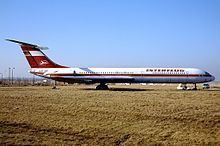Summary On-board fire Crew 8 Injuries (non-fatal) 0 Date 14 August 1972 Passenger count 148 | Passengers 148 Fatalities 156 Survivors 0 Number of deaths 156 Survivor 0 | |
 | ||
Similar Aeroflot Flight 217, Sterling Airways Flight 296, Iberia Airlines Flight 602, Japan Airlines Flight 446, Aeroflot Flight 1491 | ||
The 1972 Königs Wusterhausen air disaster occurred on 14 August when an Interflug airplane crashed shortly after take-off from Berlin-Schönefeld Airport in Schönefeld, East Germany, on a holiday charter flight to Burgas, Bulgaria. All 156 passengers and crew died, making it the second-deadliest aviation accident in the world, and the deadliest in Germany, at that time.
Contents
The crash
The Ilyushin Il-62, serial number 00702, was the first aircraft of this type operated by Interflug. It became operational in April 1970 and by August 1972 it had a history of 3,520 total airframe hours. Prior to 14 August 1972, there had never been a fatal commercial aviation incident involving an Il-62.
On 14 August 1972, the Interflug flight left Berlin-Schönefeld Airport at 16:30 local time. It being summer holiday, the number of passengers – mainly tourists intending to spend their holiday on the Bulgarian Black Sea coast – almost reached the full capacity of the plane. The pilot was 51-year-old former Luftwaffe and NVA Air Force veteran Colonel Heinz Pfaff, his co-pilot was Lothar Walther, 35. Take-off was normal, the aircraft then headed southeast towards Czechoslovakia.
Thirteen minutes into the flight, at 16:43, 8,900 metres (29,200 ft) above the city of Cottbus, East Germany, the pilot reported problems with the elevator and the aircraft had left its designated route by some 10 degrees. The pilot requested a return to Schönefeld but didn't think that the situation was critical enough for an immediate landing at the nearest airport. At 16:51 the crew carried out a fuel dumping to decrease the landing weight. Meanwhile, the flight attendants reported smoke in the rear section of the cabin. When the pilot had Berlin-Schönefeld Airport already in sight and was just a few kilometers south of it, he issued a mayday at 16:59:25 indicating that he had problems controlling the plane's altitude. A few seconds later the tail section broke off the aircraft which then entered into an uncontrolled descent during which the front part of the plane also broke off before the various parts crashed into a wooded area near Königs Wusterhausen, East Germany.
Cause
The pilot's last messages suggested that a fire in the rear of the aircraft was responsible for the accident. This part was not accessible from the cabin and had no smoke detectors, so the crew was not immediately able to realize the severity of the situation. The fire was caused by a leak in a hot-air tube through which air with a temperature of some 300 °C (572 °F) left the tube and damaged the insulation material of electrical wires and airplane control. After take-off a short-circuit caused sparks with a temperature of some 2,000 °C (3,630 °F) and a fire in cargo bay no. 4. This fire then grew until the smoke reached the passenger cabin and the fuselage structure was weakened. Finally the tail section failed in flight.
Memorial
At the cemetery of Wildau, close to Königs Wusterhausen, a memorial commemorates the victims whose names are written on a black memorial stone.
